Kids' Guernica and Peace Process in Belfast / Northern Ireland

Photo by Kevin Cooper - Photoline Photographic Agency
(see as well under photographers)
Once the mural was done its coordinator, Bernard Conlon responded appropiate to what is needed to make progress in the peace process of Belfast / Northern Ireland with a poem of his own.
Colour of Optimism
A blank canvas came to Belfast, from Japan via Athens,
As if by magic odyssey,
Blankness converted to the colour of optimism -
And power of Herculean possibility,
Derived from random children after
I canvassed widely,
A solitary, seasoned teacher led a group of girls
With novice minds and aspiration, to see
"The big picture" - weave uniqueness, tangibly,
and achieve a splash of morality?
Bernard (L) Conlon
This poem was drafted in July 2008 to commemorate the events and combined efforts that led to the first Belfast Kids’ Guernica painting that was painted in May/June 2008 and upgraded in June 2009.
Other schools, teachers and organisations were canvassed and contacted regarding the project and were given the opportunity to participate. In the end, one teacher (Cathal Cauldwell) from one school saw 'the big picture'and converted the canvas into the “Colour of Optimism.”
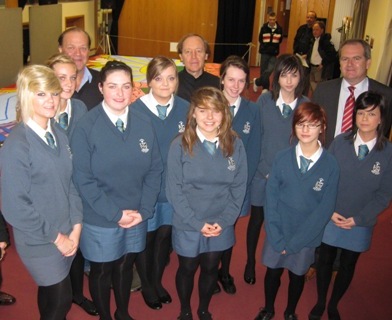
The painting was carried out by a group of 16 young people (14 year olds) from the Little Flower Secondary School, Belfast, Ireland/UK. 7 young painters from the group did the actual painting, based on the wider groups' ideas and thinking. With the group of girls are in the background as well Hatto Fischer, Boris Tissot and Bernard Conlon.
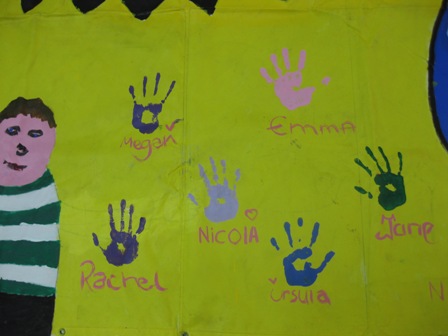
First exhibition of the Belfast Kids’ Guernica painting – Linen Hall Library, Belfast, 21 September 2009

The Belfast mural in Linen Hall Library
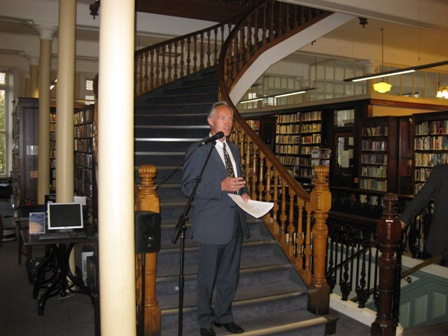
John Killen, Librarian, Linen Hall Library, Belfast delivering the opening address at the Belfast Kids’ Guernica exhibition, 21 September 2009
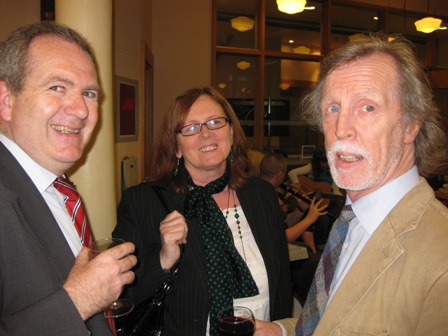
Bernard Conlon with Noreen Friel, Little Flower School and her colleague, Cathal Cauldwell, Head of Art at the school, who organised- and supervised work on the Belfast Kids’ Guernica painting.
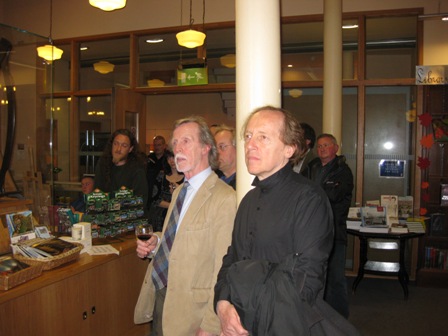
Art teacher Cathal Cauldwell listening with Boris Tissot, artist, Centre Pompidou and Member of the International Committee of Kids' Guernica who came extra from Paris for the event in Belfast.
In honor of the poets like Seamus Heaney and Michael Longley, but also Brendan Kennelly
By coincidence, but appropriately when the public viewing of the Belfast peace mural took place in the Linen Hall Library, two great poets, Seamus Heaney and Michael Longley, were honored at the same time by the library. A special display case showed books and photos of both poets. Their role in bringing about an atmosphere in which poetry could be appreciated is immense. Ever since coming into contact with Irish poets, it meant following their paths as well as that of Brendan Kennelly whose Cromwell poems addressed directly the violence which ruled in Ireland, more specifically in Northern Ireland and therefore Belfast. One of these poems shows directly what violence can do to innocent children just coming around the corner when the bomb goes off.
In the essay about 'poetry and violence' Brendan Kennelly develops a key concept of responsibility amidst poets for the violence in Ireland, insofar as myth and creation of an independent Ireland go hand in hand with the use of violence. Once the Northern Ireland conflict exploded in violence, he made the astute observation of such violence being very much the same wherever terror is spread by arbitrary bombs with innocent by-standers, children included, caught up in the process. He attests to this in his poem 'Nails':
Nails by Brendan Kennelly
The black van exploded
Fifty yards from the hotel entrance.
Two men, one black-haired, the other red,
Had parked it there as though for a few moments
While they walked around the corner
Not noticing, it seemed, the children
In single file behind their perky leader,
And certainly not seeing the van
Explode into the children’s bodies.
Nails, nine inches long, lodged
In chest, ankle, thigh, buttock, shoulder, face.
The quickly gathered crowd was outraged and shocked.
Some children were whole, others bits and pieces.
These blasted cruxifixions are commonplace.
The poem 'Nails' is taken from his Cromwell poems
Sandrine Brisset read on the occasion poems by Brendan Kennelly. The poems were 'Innocent', and 'The Stones' and 'If I, if You' from The Book of Judas
It was invaluable that she came extra from Dublin to Belfast. She appreciates Brendan Kennelly's special brand of Irish poetry because as she would put it "his poetry is born out of trully felt experience." When confronting problems of gender in Irish society and many other issues, she points out that she did not come from law to poetry, but more "from poetry to law." She has written her PhD on Brendan's poetry and is continuing research with the ultimate hope to be able to write a biography. However, as she would put it, that "is a long and demanding project."
The Linen Hall Library's "Troubles Collection"
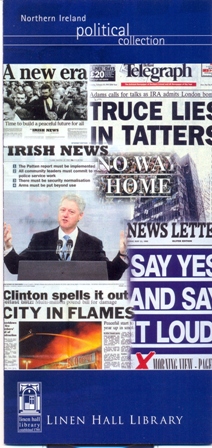
The political collection is held in a special section of the library.
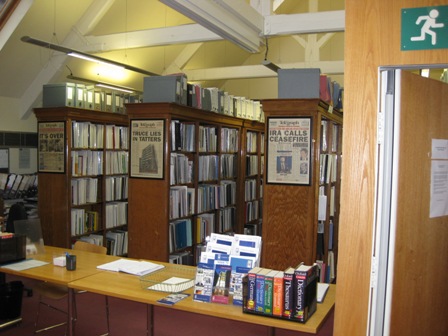
The reality of Belfast 2009
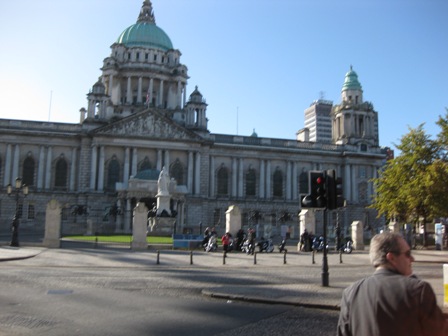
Belfast City Hall where Unionist (British) and Nationalist (Irish) elected representatives run the city
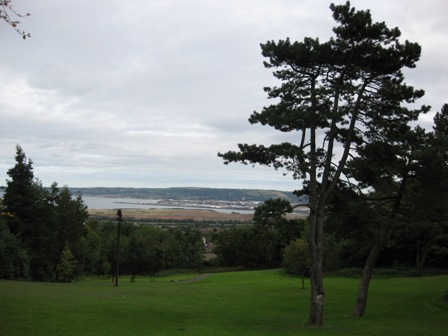
A view of the entrance to Belfast Harbour, close to where the Titanic was constructed and launched

Memorial to nine people from the unionist community killed in an explosion on Belfast’s Shankill Road, October 1993

Photographs in memory of people from the Falls Road in West Belfast in a memorial garden on the nationalist side of the “Peace Line”, which still separates the Falls Road from the unionist Shankill Road.

A security gate, on the Upper Springfield Road, opened once a year to let an Orange parade from the unionist community march a short distance on a nationalist section of road in order to reach their lodge – an annual 30 minute event requiring painstaking cross-community communication, negotiation, marshalling and policing – such is the day-to-day peace-building process.

A sea of Union Jacks on the unionist Shankill Road - more ardent, working-class unionists are referred to as loyalists. Total loyalty to the British Crown and absolute devotion to the monarch is implied.

Memorial gardens like this are dotted thoughout the parts of Belfast that were most affected by the “Troubles” (now referred to by both sides as the “conflict”). This one is in the nationalist New Lodge Road district of North Belfast and is dedicated to Republican “volunteers” (members of the Irish Republican Army/IRA) killed while participating in the IRA’s 25 year (approximately) “armed struggle” – referred to by the British governments of the time and unionists as a “terrorist campaign.” A peace process evolved in the early 1990s leading to the Republican and Loyalist ceasefires of 1995. A stalemate had been the reality for a long time and the ceasefires were effective recognition of this.
In 1998 a complex agreement between unionists, nationalists, the British and Irish governments with input from the United States and European Union (EU) support, led to the Belfast/Good Friday Agreement. It has provided a dozen years of “transitional” peace. It is an interim step towards the British and the Irish resolving their 800 year relationship and the British and Irish identities within Ireland learning to appreciate and accommodate each other.
It is a tentative and template process, with the two islands veering towards partnership. The two identities, or traditions as they are called, seem to be slowly letting go of hurt and suspicion. A weaning off “the physical force tradition” on one hand and away from triumphalism and supremacy on the other is still a work in progress…
Writings on the Walls
Wall murals were an integral aspect of the "troubles"/conflict and brought across pain, loyalities, and memories of those killed. Nowadays while they are conveying increasingly broader and less volatile messages, they still retain their distinct (and separate) identity and tone.
Invoking Ireland’s tragic past: remembering the Potato famine of the 1840’s. The New Lodge Road, Belfast provides a bleak urban setting for pathos and self-conscious folk memory. A bit surreal, maybe; a measure of artistic merit, certainly.


International Wall, Falls Road, Belfast

Replica of Picasso's Guernica, International Wall, Belfast

Heroes, villans, romance, mythology, humour, solidarity, commemoration, celebration and yes, propaganda, the International Wall has it all…

and inevitably, Che Guevera. The Basque Country and the...

And the Middle East gets also a look-in

New model mural: the Belfast version of Soviet social realism? The children are happy and smiling and the communities content. The image belies widespread apathy, anti-social behaviour and the highest youth suicide rates in Western Europe.
Further Sightings of Picasso's Guernica in Belfast – reflecting the Belfast-Basque connection?

Replica of Picasso's Guernica at entrance to pub
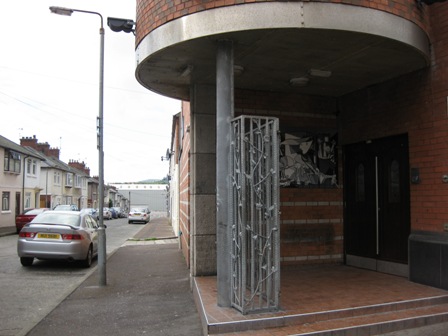
Another angle of the same pub corner
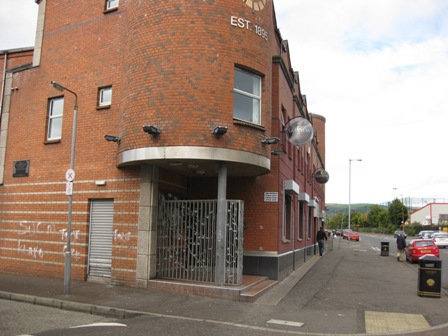
Street corner with Picasso's Guernica
2012
Looking back or forward, that is like looking down or up the street. At every corner there is someting reminscent about what took place in this city still divided by the peace wall / fence which is in places much higher than what the Berlin was ever.
Recently Gabriel Rosenstock sent an article called "Missing the Bus: Poetry and Social Relevance" which deals with that complicated moment when someone crosses that line dividing the two communities not merely in physical but social spaces. He cites a poem which amounts to reaccounting how a Catholic gave light to a Protestant who wished to smoke his cigarette. Since the wind was very strong, they had to bring their hands closer together in order to form a cup to shelter both lighter and cigarette. It came for one brief moment just to one 'touch'. After that things unravel. Imagine what, asks himself in disbelief the man who had missed the bus and now sits in one after he had this to encounter? He could never have imagined that he would touch the other considered till then to be 'untouchable', but not in the way it is understood in India. And then despite of that it came to that real encounter!
There is also the story told about someone revisiting that divided city and making his observations - see
« Martinique - the abolition of discrimination | Further reflections since 2007 - 2010 by Bernard Conlon »
